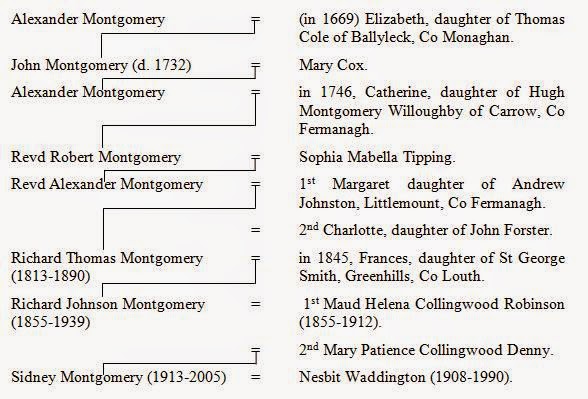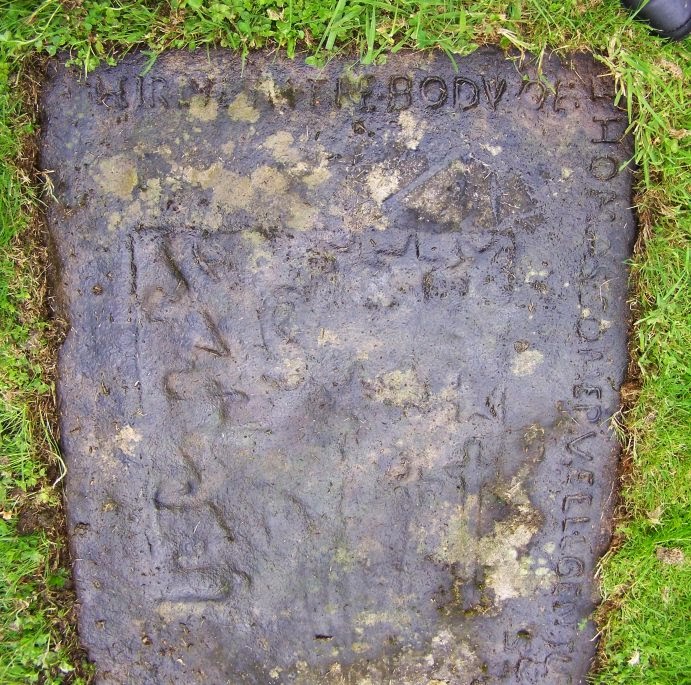The present Church of Ireland (St Brigid’s) at Beaulieu was built with a square two-storey tower in 1807 with the assistance of a gift of £600 from the Board of First Fruits. In 1955 the roof collapsed and had to be replaced. On the resignation of Revd Edward Groome, who had been rector from 1831 to 1872, Beaulieu was grouped with Ballymakenny parish, and in 1877 it became part of Termonfeckin union. The church is no longer used regularly for service. It is said that the remains of a pre-Reformation Archbishop, John Prene (1439-43), lie in a vault beneath the church (Fleming 2000, 228). The gravestone inscriptions to 1900 in Beaulieu churchyard are given in this Journal (1981, vol xx, no. 1, pp. 57-60) and the inscriptions post 1900 are given in the Journal of the Old Drogheda Society. The inscriptions appearing on the monuments and brasses inside the church follow:
Sacred to the memory of the Revd Jerome Alley, L.L.B. for 37
years Rector, of the Parishes of Beaulieu and Drumcar in this diocese; a pious
and learned minister of the Gospel. He was the author, of that able defence of
the christian religion, “Vindiciæ Christianæ”: in the composition of which, he
had been engaged for several years; he lived just long enough to see this work
published; and died on the 21st May, 1827, in the 69th
year of his age, relying on the consolations and promises, of that religion,
which his pen had so ably vindicated. This Monument has been erected by the
piety and affection of his son, Captn Wm. Hy.
Alley, and of his grand-daughters, Sophia and Maria Alley, the only children of
his eldest son, Captn. Holroyd Alley, deceased.
Memoriæ Revdi Hieronimi Alley L.L.B., M.R.I.A.,
Nuper hujus parochiæ rector qui hâc vitâ decessit Die Maii XXI A.D. MDCCCXXVII
et ætatis suæ LXXI. Sacerdotis Christiani officio fideliter functus per annos
quandraginta et octo in spê certa gloriæ sempiternæ per Christum. Hoc
monumentum dicatum est pro documento pietatis et reverentiæ. Filio ejus maximo
natu superstiti Hieronimo Alley clerico parochiæ Sancti Andriæ in Novâ
Brunswigia Rectore.
In memory of Francis Donagh, of Newtown, Co. Louth Esq J.P. An upright
Magistrate, a munificent benefactor, and an humble Christian. Born 9th
Aug. 1800, died 3rd Oct. 1885 aged 85 years. This tablet is here
placed in grateful remembrance by his friend, Arthur Ellis J.P. W. Sawier, Dublin.
D onagh
Sacred to the memory of Philip Donagh Esqr of Newtown, who
died on the 14th of May 1820 in the eighty third year of his age,
and was interred in this church yard. This monument is inscribed as a grateful
record of a kind and affectionate parent by his only son, Francis Donagh.
Donagh
To the glory of God and in memory of Francis Donagh Esqr of
Newtown, Drogheda, died 3rd October 1885, erected by George Charles
Smyth.
(on brass underneath the stained glass window)
Donagh
In memoriam infra positi Philippi Donagh, hoc posuere monumentum seniores
ejusdem filii Antonius et Lucas obiit 25o die Iunii 1721 ætatis anno
58. Laurana uxor Philippi supra memorati obiit quinto Marcii 1750 ætatis anno
80.
The Donagh Arms
Groome
This gallery is a memorial of Fanny Emily Groome, the beloved wife of
the Revd Edward Groome rector of this parish who before she died
Febry 26th 1845 collected subscriptions for it. Mark 14th
C. & 9th V.
Sacred to the memory of Margaret, wife of the Revd Alexr
Johnston, of Beaulieu who on their marriage assumed her sirname, and whose
pride and happiness, she formed for more than fifteen years. She died at
Bordeaux whither she had been ordered for the recovery of her health on the 15th
of October 1824. Leaving to her grateful and afflicted husband and her nine children,
(the youngest of whom in a few days after rejoined the spirit of his beloved
mother) an invaluable legacy in a bright example of conjugal and maternal love,
controlled and regulated by a sound understanding and habitual piety.
{And now, Lord, what is my hope: truly my hope is even in Thee. Ps.
39th.
P. Turnerelli Fecit, London.
The Johnston arms, crest and motto
To the glory of God and in loving memory of John Leland of
Beltichburne, born 1836, died 1927. Church warden and benefactor of this church
for 40 years. This tablet is erected by his family.
Moss
Montgomery
Sacred to the memory of Willoughby Tichbourne Montgomery aged 19,
Canadian Mounted Rifles, killed in France July 26th 1916. For God and
Country.
Gawthorp & Sons London.
The Montgomery Crest
Montgomery
Sacred to the memory of Miss Mary Eliza Montgomery who
died 1st March 1811, aged 25 years. Amiable, accomplished, and pious, those
qualities and the attainments of a mind highly improved were united with great
benevolence and most engaging manners and always directed to friendship to
innocent pleasure, to sympathizing with the sorrowful and relieving the
distressed. In her illness she disclosed no anxiety but for her parents to whom
she was most affectionate and most dutiful. For she contemplated the awful
event of her dissolution with humble resignation to the will of the allwise
being who in his bounty giveth and in his wisdom taketh away. The recollection
of her many virtues and sincere piety is the great consolation of her severely
afflicted parents, Robert and Sophia Montgomery.
Montgomery
Here lie the remains of Mrs Sophia M Montgomery the mother
of the sd Mary Eliza and one of the coheirs of Henry the last Lord Baron
Ferrard of Beaulieu. She died on the 21st of May 1812 leaving to her friends
and to her children the example of a life in which might be observed a strict
attention to every moral virtue and every Christian duty. This monument sacred
to the memory of one of the best of wives and most beloved child is erected by
their disconsolate survivor Robert Montgomery.
Montgomery
Sacred to the memory of the Revd Robert Montgomery, rector of
Monaghan, who died at Beaulieu on the 24th of July 1825 aged 72
years. Throughout the course of a long life and in most trying circumstances,
which a strong sense of religion enabled him to support, by his mildness,
benevolence, and integrity, he won the respect and affection of all who had the
happiness of knowing him, and of observing in him the union of the gentleman
and the truly Christian pastor. This monument is erected as a tribute of love
and veneration to the best of parents by his grateful and afflicted children
Alexr Johnston CLK, Thos Montgomery R.N., Kath. Salisbury
Hamilton and Sidney Montgomery. P.
Turnerelli fecit.
The arms of 1. Montgomery, 2. Willoughby, 3 Cole, 4 Montgomery
along with an escutcheon of pretence for Tipping,
Montgomery crest and motto.
Price (plaque in the porch)
Price wife | ye
sd James who | depd this life | august ye ? 1714 | in ye
77 year | of her age.
Smyth
To the glory of God and in loving memory of Ralph Smyth born 21st
June 1873, died 12th September 1902, eldest son of George Charles
& Ada Smyth, Newtown, Drogheda. Interred in this churchyard. J & C McGloughlin
Ltd, Dublin.
There are three shields of heraldic interest in
the church. The monument to Philip and Laurena Donagh bears the Donagh arms,
crest and motto ‘Probitas est optima virtus’ (‘Uprightness
is the best of virtue’).
The Johnston monument carries the family coat of arms along with the crest and motto
‘Nunquam non paratus’ (‘Never unprepared’). Revd Alexander Montgomery (see
Johnston inscription) assumed by royal licence the surname and arms of Johnston
in lieu of Montgomery, in compliance with the will of his wife’s brother,
Arthur Johnston of Littlemount, Co Fermanagh.
Sir Henry Tichborne of Beaulieu
who was created Lord Ferrard in 1715 married in 1683, Arabella Cotton. Their
two sons, Henry and William, did not have male heirs, then Beaulieu passed to
their daughter, Salisbury Tichborne, and her husband, William Aston. Their daughter,
Sophia Aston, married Thomas Tipping and in turn, their daughter,
Sophia-Mabella Tipping, married Revd Robert Montgomery. Thus the family name
changed four times in as many generations, from Tichborne to Aston to Tipping
to Montgomery. The family name was to
remain Montgomery until the late Sidney Montgomery married Nesbit Waddington.
The quartered arms on the monument to Revd Robert Montgomery depict
the Montgomery, Willoughby, Cole and Montgomery arms along with the Tipping
arms as an inescutcheon of pretence. The Montgomery motto and crest are
included. The monument in Monaghan Church of Ireland to Captain Thomas
Montgomery (second son of Revd Robert) carries a nine-quartered coat of arms
which is also displayed at Beaulieu House. These arms were granted to Thomas’s
son, George Samuel Montgomery in 1872. The nine families are Montgomery, Cole,
Montgomery (Earl of Mount Alexander), Tipping, Aston, Tichborne, Lyerstrum,
Loveday and Bysse. Henry Tichborne’s mother was Judith Bysse. The other
families of Lyerstrum and Loveday are further back in the Tichborne pedigree.
The broken lance which forms the Montgomery crest is depicted on the
plaque to Willoughby Montgomery. The crest was adopted in memory of the
tournament of 10 July 1559 when Gabriel Montgomery had the misfortune to
accidentally kill the French King Henry II. The Montgomery motto is ‘Patriae
infelici fidelis’ (‘faithful to an unhappy country’).
BIBLIOGRAPHY
Burke, B. 1884 General Armory of England ,
Scotland , Ireland
Fleming, W.E.C. 2001 Armagh
Clergy 1800-2000, Dundalk.
ACKNOWLEDGEMENTS
Ms Cara Konig-Brock, her late
mother and grandmother, Mrs Gabriel Konig and Mrs Sidney Waddington respectively,
Declan Quaile and Noel Ross.
APPENDIX
1: MONTGOMERY PEDIGREE
APPENDIX
2: FAMILY COATS OF ARMS
Aston Argent
a fess and in chief three lozenges sable.
Bysse Sable three
escallops in pale argent.
Cole Argent a bull passant sable armed
and unglued or, within a bordure or charged with eight bezants, on a canton
sinister per pale gule and azure a harp gold, stringed of the field.
Donagh Per chevron invected or and vert, in
chief two lions passant guardant gules in base a boar passant argent armed and
bristled or, langued gules.
Johnston (exemplified to Revd Alexander Montgomery,
of Beaulieu, Co Louth) Argent a saltire sable between three shamrocks slipped,
and in base a human heart ensigned with an imperial crown proper, on a chief
gules three cushions or.
Loveday Azure, three bars
dancettée or.
Lymerston Argent three eagles displayed gules a
bordure azure charged with eight bezants.
Montgomery (Earl of Mount Alexander, extinct 1757) Quarterly,
1st and 4th azure three fleurs-de-lis or, for Montgomery;
2nd and 3rd gules, three annulets
or, gemmed azure, for Eglington, all within a bordure gold, charged
with a double tressure flory counterflory gules on a surcoat of the last a
sword and sceptre saltireways proper.
Montgomery (confirmed to Major-General
George Samuel Montgomery C.S.I.)
Gules two spears in saltire between three
fleurs-de-lis in chief and as
many annulets in base or, stoned azure.
Tichborne (Baron Ferrard, extinct
1731) Vair a chief or, a mullet for difference.
Tipping (Beaulieu, Co Louth)
Azure three sceptres erect or, on a canton gules a
dove with an olive branch in the beak all proper.
Tipping Azure a chevron between three
sceptres bendways or, on a canton argent a dove with an olive branch in the
beak all proper.
Willoughby Or, fretty azure.
The multi-quartered arms 1. Montgomery, 2. Cole, 3. Montgomery, 4, Tipping, 5. Aston, 6. Tichborne, 7. Lyerstrum, 8. Loveday, 9. Bysse


























